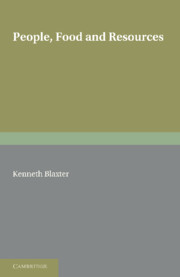Summary
THE RESOURCES FOR FOOD PRODUCTION
Land has already been mentioned as the basic resource on which food production depends. Land must have a supply of water and an equitable temperature as well as an intrinsic fertility if it is to produce a crop. A second resource is the labour of man, a resource which should include the ingenuity, inventiveness and skill of those who breed new crop plants or devise new husbandry techniques, as well as of those who till the fields and tend the stock. In many subsistence societies, land and labour are the sole resources, and this is true of many communities within the developing world. In more advanced agricultures there is a third resource which can be termed the industrial or ex-farm resource. This resource includes equipment and machinery, fuel and power applied in farm operations, fertilisers, agrochemicals for pest, disease and weed control, and transport. These inputs into farming are relatively new and have the effect of expanding the limits of agriculture beyond the immediate fields of the farmer's endeavours. In Britain such an enlargement began with the emergence of wrights and smiths as people separate from the farm proper, making equipment for farm use. It continued with the establishment of machinery manufacturers, and, with the discovery of artificial fertilisers and chemical means of augmenting crop yield and animal production, the process has accelerated further.
- Type
- Chapter
- Information
- People, Food and Resources , pp. 59 - 75Publisher: Cambridge University PressPrint publication year: 1986



